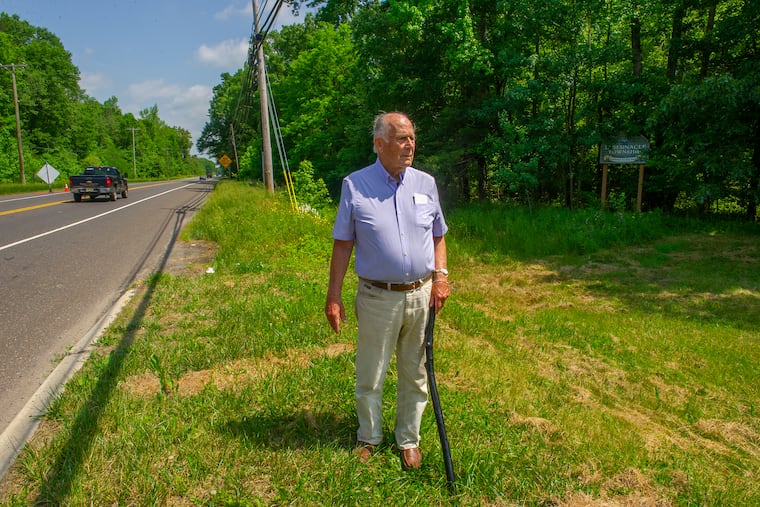New Jersey couple donate their land to Native Americans whose ancestors once called it home
Jim and Margaret Hogan thought it was time to give back to the Native Americans who have lived in Burlington County for centuries. So they donated their land.

Jim and Margaret Hogan bought a historic piece of rural Burlington County for $9,000 in 1973. The wooded 1½-acre lot on Route 206 at Tuckerton Road had once been part of a storied community called Brotherton — the first and only reservation for indigenous people ever established in what is now New Jersey.
“We didn’t know that when we bought it,” said Jim Hogan, 84, a retired construction-equipment salesman who lives in Mount Laurel. “A family from Pennsylvania sold it to us. It was all commercially zoned and we thought this area, on a major highway, would be the next Cherry Hill.
“Boy, were we wrong,” Hogan, an avuncular father of five and grandfather of seven, told me when I met him at the site. The surrounding area is still mostly rural, and his former piece of property remains verdant and vacant, except for the farm stand on wheels he built and operated for a couple of summers.
“We tried to sell this land on and off, and after the last sale fell through in 2017, we decided to donate it to the Indians for a dollar," said Hogan, who uses a walking stick he crafted from a fallen branch he found there and painted black. “The history of the United States and the Indians is not too good, and we wanted to do something for them.”
Burlington County records show that the Hogans conveyed their deed to the lot in Tabernacle Township to an organization called the Brotherton Indian Reservation, in Denville, Morris County, as of Sept. 5, 2018.
The original reservation of 3,000 acres in what are now Tabernacle and Shamong Townships was established in 1758. In his well-researched 2005 book Brotherton, retired South Jersey historian and archaeologist George D. Flemming wrote that setting aside the land was part of an effort to persuade indigenous groups to relinquish claims on land elsewhere in the colony, and maintain peace.
Told of Hogan’s efforts, Flemming, who now lives in South Carolina, said: "That’s good. I’m all for helping the Indians, that’s for sure.”
At its peak, Brotherton was home to perhaps 200 Leni-Lenape, or Delaware, people, who had hunted and fished in the region for thousands of years. But the Revolutionary War, the death of a major benefactor named John Brainerd, and disagreements among residents about leasing or selling land to white settlers disrupted life on the reservation, which became smaller and more deeply impoverished.
In 1802, New Jersey sold off pieces of the reservation to private buyers. Most of the remaining residents left for other indigenous communities outside New Jersey, including that of the Oneidas, in Upstate New York.
Joseph Barton, the mayor of Tabernacle — a 50-square-mile township, incorporated in 1901, that has about 6,800 residents — said he was not aware of the transfer of the deed. “Unless the [new owners] have some sort of federal exemption, they would have to come before our zoning and planning board, as well as the Pinelands Commission, with any plan for building something there,” he said.
I called the reservation group in Denville several times during the week, but the voicemail was full. An email also went unanswered. I was able to get in touch with Joseph Littlefeather, who said he is the recently elected chief of a New Jersey group called the Sandhill Lenape Cherokee Tribe.
“I want to thank him [Hogan] for doing this,” said Littlefeather, a 71-year-old Denville resident. “We want to put a farm stand on the land, and eventually open an office there, so people who live down there don’t have to travel so far.”
Although there are no federally recognized Native American tribal groups in the state, in March the office of New Jersey Attorney General Gurbir S. Grewal announced it had reached settlements affirming the state-recognized status of the Powatan Renape and Ramapough Lenape nations.
“We don’t receive any money from the State of New Jersey and we don’t have anything to do with the Bureau of Indian Affairs,” said Littlefeather, adding that his organization represents hundreds of descendants of what are sometimes called the Brotherton Indians, including perhaps 30 who live on or near the reservation site.
“It still is the Brotherton Reservation,” Littlefeather said. “They [New Jersey authorities] sold property that wasn’t theirs to sell.”
If native people reestablish a presence on even a little piece of their former homeland, non-Indian residents and property owners have nothing to fear, said Littlefeather.
“We’re not going to go down there and throw everybody out of their houses,” he said.
I would certainly hope not. And Hogan feels the same way.
“I would love to see them be able to come back,” he said. “The Indians were here before anybody else. They should be able to use this ground.”
I couldn’t agree more.